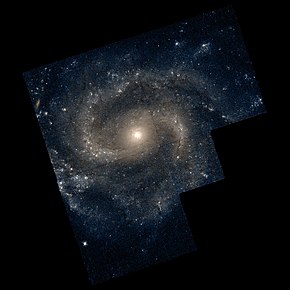| NGC 1042 | |
|---|---|
 | |
| Observation data (J2000 epoch) | |
| Constellation | Cetus |
| Right ascension | 02h 40m 24.0s[1] |
| Declination | −08° 26′ 01″[1] |
| Redshift | 0.004573 ± 0.000007[1] |
| Heliocentric radial velocity | 1,371 ± 2 km/s |
| Distance | 55.5 Mly (17.02 Mpc) |
| Apparent magnitude (V) | 14.0[1] |
| Characteristics | |
| Type | SAB(rs)cd[1] |
| Size | 39,200 ly |
| Apparent size (V) | 2.3′ × 1.0′ [1] |
| Other designations | |
| MCG -02-07-054, IRAS 02379-0838, PGC 10122[1] | |
NGC 1042 is a spiral galaxy located in the constellation Cetus. The galaxy has an apparent magnitude of 14.0.
NGC 1042 is a low-luminosity active galaxy.[2][3] Furthermore, its luminosity class is III-IV and it has a broad HI line.[4] It is known that NGC 1042 also hosts an intermediate-mass black hole in its center.[5]
NGC 1042 contains an ultraluminous X-ray source called NGC 1042 ULX1.[6]
Morphology
[edit]NGC 1042 is a late-type galaxy, classified as type SAB(rs)cd.[7] It has a bulgeless structure with spiral arms consisting of two symmetric arms located in the inner side with ceaseless long outer arms, with an Arm Class 9 classification.[8] The spiral galaxy type of NGC 1042 is a mystery; some astronomers classified it a barred spiral galaxy based on ellipse fitting via B- and H-band images,[9] while others classified it an unbarred spiral galaxy.[10][11] Further evidence by them suggests, the inner arms of NGC 1042 are curved with a bar-like structure that is mistaken as a bar.[12][3]
Nearby galaxies
[edit]NGC 1042 appears near the spiral galaxy NGC 1035 in the sky, with both having similar redshifts. The two objects may therefore be physically associated with each other.[13] In additional, NGC 1042 is also a member of the NGC 1052 group.[14] It is shown to be the only galaxy with a large gas reservoir, indicating it was stripped of gas during a past interaction with NGC 1052.[15]

References
[edit]- ^ a b c d e f g "NASA/IPAC Extragalactic Database". Results for NGC 1042. Retrieved 2006-12-03.
- ^ Böker, T.; Schinnerer, E.; Lisenfeld, U. (2011-09-21). "Molecular gas around low-luminosity AGN in late-type spirals". Astronomy & Astrophysics. 534: A12. arXiv:1108.1786. Bibcode:2011A&A...534A..12B. doi:10.1051/0004-6361/201117262. ISSN 0004-6361.
- ^ a b Luo(罗荣欣), Rongxin; Hao, Lei; Blanc, Guillermo A.; Jogee, Shardha; Bosch, Remco C. E. van den; Weinzirl, Tim (2016-05-25). "THE VIRUS-P EXPLORATION OF NEARBY GALAXIES (VENGA): RADIAL GAS INFLOW AND SHOCK EXCITATION IN NGC 1042". The Astrophysical Journal. 823 (2): 85. arXiv:1603.07928. Bibcode:2016ApJ...823...85L. doi:10.3847/0004-637x/823/2/85. ISSN 0004-637X.
- ^ "Detailed Object Classifications for NGC 1042". ned.ipac.caltech.edu. Retrieved 2024-08-01.
- ^ Shields, Joseph C.; Walcher, C. Jakob; Böker, Torsten; Ho, Luis C.; Rix, Hans-Walter; van der Marel, Roeland P. (2008-07-20). "An Accreting Black Hole in the Nuclear Star Cluster of the Bulgeless Galaxy NGC 1042". The Astrophysical Journal. 682 (1): 104–109. arXiv:0804.4024. Bibcode:2008ApJ...682..104S. doi:10.1086/589680. ISSN 0004-637X.
- ^ Ghosh, Tanuman; Rana, Vikram (2022-10-21). "Spectral variability in NGC 1042 ULX1". Monthly Notices of the Royal Astronomical Society. 517 (3): 4247–4255. arXiv:2209.02458. doi:10.1093/mnras/stac2979. ISSN 0035-8711.
- ^ de Vaucouleurs, Gerard; de Vaucouleurs, Antoinette; Corwin, Herold G., Jr.; Buta, Ronald J.; Paturel, Georges; Fouque, Pascal (1991-01-01). Third Reference Catalogue of Bright Galaxies. Bibcode:1991rc3..book.....D.
{{cite book}}: CS1 maint: multiple names: authors list (link) - ^ Elmegreen, Debra Meloy; Elmegreen, Bruce G. (1987-03-01). "Arm Classifications for Spiral Galaxies". The Astrophysical Journal. 314: 3. Bibcode:1987ApJ...314....3E. doi:10.1086/165034. ISSN 0004-637X.
- ^ Marinova, Irina; Jogee, Shardha (2007-04-20). "Characterizing Bars atz∼ 0 in the Optical and NIR: Implications for the Evolution of Barred Disks with Redshift". The Astrophysical Journal. 659 (2): 1176–1197. arXiv:astro-ph/0608039. Bibcode:2007ApJ...659.1176M. doi:10.1086/512355. ISSN 0004-637X.
- ^ Weinzirl, Tim; Jogee, Shardha; Khochfar, Sadegh; Burkert, Andreas; Kormendy, John (2009-05-01). "Bulge n and B/T in High-Mass Galaxies: Constraints on the Origin of Bulges in Hierarchical Models". The Astrophysical Journal. 696 (1): 411–447. arXiv:0807.0040. Bibcode:2009ApJ...696..411W. doi:10.1088/0004-637X/696/1/411. ISSN 0004-637X.
- ^ Li, Zhao-Yu; Ho, Luis C.; Barth, Aaron J.; Peng, Chien Y. (2011-12-01). "The Carnegie-Irvine Galaxy Survey. II. Isophotal Analysis". The Astrophysical Journal Supplement Series. 197 (2): 22. arXiv:1111.4606. Bibcode:2011ApJS..197...22L. doi:10.1088/0067-0049/197/2/22. ISSN 0067-0049.
- ^ Buta, R.; Vasylyev, S.; Salo, H.; Laurikainen, E. (2005-08-01). "The Distribution of Bar and Spiral Arm Strengths in Disk Galaxies". The Astronomical Journal. 130 (2): 506–523. arXiv:astro-ph/0505079. Bibcode:2005AJ....130..506B. doi:10.1086/431251. ISSN 0004-6256.
- ^ A. Sandage; J. Bedke (1994). Carnegie Atlas of Galaxies. Washington, D.C.: Carnegie Institution of Washington. ISBN 978-0-87279-667-6.
- ^ Kourkchi, Ehsan; Tully, R. Brent (2017-07-01). "Galaxy Groups Within 3500 km s-1". The Astrophysical Journal. 843 (1): 16. arXiv:1705.08068. Bibcode:2017ApJ...843...16K. doi:10.3847/1538-4357/aa76db. ISSN 0004-637X.
- ^ van Dokkum, Pieter; Danieli, Shany; Romanowsky, Aaron; Abraham, Roberto; Conroy, Charlie (2019-02-01). "The Distance to NGC 1042 in the Context of its Proposed Association with the Dark Matter-deficient Galaxies NGC 1052-DF2 and NGC 1052-DF4". Research Notes of the AAS. 3 (2): 29. arXiv:1902.02807. Bibcode:2019RNAAS...3...29V. doi:10.3847/2515-5172/ab05d6. ISSN 2515-5172.
External links
[edit] Media related to NGC 1042 at Wikimedia Commons
Media related to NGC 1042 at Wikimedia Commons- Picture of NGC 1042
- NGC 1042 on WikiSky: DSS2, SDSS, GALEX, IRAS, Hydrogen α, X-Ray, Astrophoto, Sky Map, Articles and images
Well, that’s interesting to know that Psilotum nudum are known as whisk ferns. Psilotum nudum is the commoner species of the two. While the P. flaccidum is a rare species and is found in the tropical islands. Both the species are usually epiphytic in habit and grow upon tree ferns. These species may also be terrestrial and grow in humus or in the crevices of the rocks.
View the detailed Guide of Psilotum nudum: Detailed Study Of Psilotum Nudum (Whisk Fern), Classification, Anatomy, Reproduction